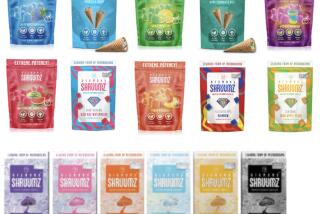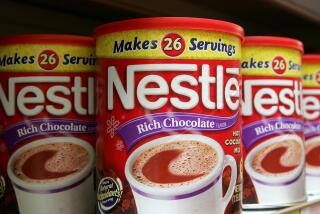Candy Companies Now Enjoy Taste of Success : Food: Consumption of chocolates and other sweets is up as the industry tries new marketing approaches.
- Share via
Candy really is dandy if you listen to groups such as the Chocolate Manufacturers Assn. It doesn’t cause acne, they say, won’t rot your teeth or make you fat and it doesn’t make kids squirm uncontrollably on long car rides.
Using industry-sponsored medical studies to bolster their claims, U.S. candy makers are persuading American consumers to just say yes to Godiva chocolates, M&M;/Mars, Nestle, Hershey and Brach’s.
In addition, they are reaching out to older candy buyers and the health-conscious with new products and marketing strategies. This Halloween--one of the most important holidays for the candy business--some retailers are seeing the push pay off.
“This is the busiest time of year for us,” said Joan Fernbacher, the owner of Candy Alley in Brentwood. “We get bicyclists coming back from a ride, and we get people who come in and say, ‘I’m on a diet, but I’ll take a small bag of jelly beans or candy corn home anyway.’ ”
Fernbacher is only one confectioner who is cashing in on the nation’s growing sweet tooth. Candy sales have steadily increased as consumers find they can fit an occasional chocolate bar or other treat into their diets.
“There were a lot of health concerns about candy in the ‘70s--it would give you acne and rot your teeth,” said Edward L. Bjornson, executive vice president of the National Candy Brokers Assn. “But people have recognized that there’s a place for confections. It’s not one of the four food groups or a staple in our diet, but it’s an affordable treat you can enjoy in moderation.”
Dietitians began suggesting in the late 1970s that an occasional chocolate bar wouldn’t hurt. After a lag of a decade, health-conscious shoppers began to accept sweets more readily, leading to a proliferation of candy bars and non-chocolate sweets.
Candy manufacturers, while trying to latch on to a new generation of sugar fiends, are tapping an enlarging adult market with higher-priced gourmet candies and sweets that were popular at stores decades ago.
Candy stores have been finding more middle-aged sweet tooths bellying up to the counter for a Sugar Daddy, Abba-Zabba, Bit ‘o Honey or stick of Beeman’s chewing gum--as they had in their elementary school days, according to industry trade groups.
“For some people, eating candy and chocolate brings back childhood memories,” said Richard T. O’Connell, president of the National Confectioners Assn. “Others use candy as a self-reward. It’s a pause in consumers’ hectic lifestyles.”
The increase in confection sales comes after years of attempts by the candy industry to persuade medical specialists to dispel what candy makers say are myths about chocolate and candy consumption.
In brochures such as the recently published “The Sweet Truth,” from the National Confectioners Assn., the industry has used scientific research to refute commonly held beliefs. Major myths that it tries to debunk concern candy’s supposed links to obesity, acne and dental ills.
Not all medical professionals buy the industry argument, and candy makers are hard-pressed to show that their wares offer much more than empty calories.
Some candy makers have begun to alert consumers that they use real fruit juices in products, such as Star Burst and Skittles bite-size candies. Other companies have introduced new brands, such as Lifesavers with real fruit juice. Over the years, candy makers have added nutritional information to their wrappers--for consumers wanting to monitor their caloric intake.
Recently there has also been a growing line of sugar-free candies and dark chocolate bars aimed at the more mature consumer. With products such as Milky Way Dark candy bars, M&M;/Mars has targeted a growing consumer market over 18. Candy “is no longer confined to little kids on Halloween,” one industry source said.
Candy makers also have tried to improve their image and diversify their customer base to include the health-conscious by sponsoring sporting events. M&M;/Mars, for example, was a sponsor of the 1984 Los Angeles Olympics and is now sponsoring the 1992 Olympics. Hershey has sponsored the National Track & Field Youth Program, which allows children to participate in sporting events to promote physical fitness, the company said.
Last year, Americans on average ate 20.5 pounds of candy--4.4 more than in 1981--to match the level of 1945, the year when World War II sugar rations were lifted. Between 1987 and 1990 alone, candy consumption, including chocolate, jumped by more than two pounds annually.
Sweet Talk Although chocolate is still considered to contain empty calories, candy industry campaigns are attempting to counter negative claims. Below are excerpts from a publication by the Chocolate Manufacturers Assn. in defense of the maligned confection. Myth: Chocolate promotes tooth decay. Fact: A number of studies in dental literature support the conclusion that eating chocolate does not cause an increase in dental caries. Myth: The caffeine in chocolate overstimulates children, causing them to become hyperactive. Fact: Symptoms such as excitement and sleeping disturbances can occur after consuming high levels of caffeine (450-900 mg, the equivalent of five to 10 cups of strong coffee). A 1.5-ounce milk chocolate bar contains only 9 mg of caffeine. A child would have to eat more than 50 chocolate bars to get the lowest amount of caffeine that has been shown to produce symptoms of caffeinism. Myth: Chocolate aggravates acne. Fact: Numerous studies in the medical literature have disproved any link between chocolate and acne. Experiments at the University of Pennsylvania found that consumption of chocolate had no effect on the incidence of acne vulgaris. ... Professional dermatologists today do not link acne with diet. Myth: Eating chocolate and other confections is the major cause of obesity in children. Fact: Researchers at Michigan State University have found that obese children consume less sugar than those of normal weight. Rather the overweight children eat more fats and protein ... and exercise less.
Sweet Talk Although chocolate is still considered to contain empty calories, candy industry campaigns are attempting to counter negative claims. Below are excerpts from a publication by the Chocolate Manufacturers Assn. in defense of the maligned confection. Myth: Chocolate is a non-nutritious food. Fact: A 1.5-ounce bar of milk chocolate supplies the following percentages of the U.S. Recommended Daily Allowance: Calcium--9%; Riboflavin--9%; Protein--6%; Iron--3%; Vitamin A--2.4%; Thiamine--2% Myth: Chocolate is high in sodium. Fact: A 1.5-ounce bar of unsweetened or semisweet chocolate contains only 1.5 mg. of sodium; a bar of milk chocolate, 40 mg. Myth: Chocolate promotes tooth decay. Fact: A number of studies in dental literature support the conclusion that eating chocolate does not cause an increase in dental caries. Myth: The caffeine in chocolate overstimulates children, causing them to become hyperactive. Fact: Symptoms such as excitement and sleeping disturbances can occur after consuming high levels of caffeine (450-900 mg, the equivalent of five to 10 cups of strong coffee). A 1.5-ounce milk chocolate bar contains only 9 mg of caffeine. A child would have to eat more than 50 chocolate bars to get the lowest amount of caffeine that has been shown to produce symptoms of caffeinism. Myth: Chocolate aggravates acne. Fact: Numerous studies in the medical literature have disproved any link between chocolate and acne. Experiments at the University of Pennsylvania found that consumption of chocolate had no effect on the incidence of acne vulgaris. . . . Professional dermatologists today do not link acne with diet. Myth: Eating chocolate and other confections is the major cause of obesity in children. Fact: Researchers at Michigan State University have found that obese children consume less sugar than those of normal weight. Rather the overweight children eat more fats and protein ... and exercise less.
Sweet Tooth Americans consumed almost four pounds more confections in 1990 than a decade earlier, with chocolate the No. 1 choice. Source: Census Bureau
More to Read
Eat your way across L.A.
Get our weekly Tasting Notes newsletter for reviews, news and more.
You may occasionally receive promotional content from the Los Angeles Times.








